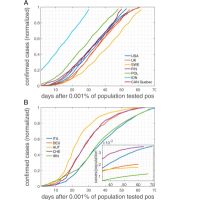Widespread testing for COVID-19 derives important epidemiological data that can inform strategies on disease monitoring and control. However, shortages of test kits and bottlenecks in processing of results prevent many countries from implementing mass testing. This leaves many patients (especially those not showing symptoms) untested, increasing their likelihood of spreading the virus.
You might also like:Refusal to Be Tested: What to Do?
A new study (Sahajpal et al. 2020) has proposed a mass population screening based on the sample-pooling method, which can be adopted by laboratories using reverse transcription polymerase chain reaction (RT-PCR) to test for COVID-19. This pooling approach will enable countries to catch up with testing needs given reduced times in analysing results.
Methodology
RT-PCR has two main components: 1) RNA extraction from clinical specimens; and 2) RT-PCR-based detection of SARS-CoV-2 nucleic acid regions. Researchers determined the number of reactions/runs required to test 940 patients in routine (or individual) screening versus mass population screening based on the incidence of COVID-19 in the United States and China. For example, mass screening in the U.S. has a potential to test 940 patients in 118 reactions/2 runs compared to 940 reactions/10 runs using PerkinElmer assay.
Also, in routine screening, the number of samples that could be tested in a 96-well RT-PCR plate varies from 30 to 94.
For this study, 940 nasopharyngeal-swab samples (934 negative and 6 positive) previously tested for SARS-CoV-2 were de-identified and assigned random numbers for analysis. Researchers were able to create 94 pools with 10 samples each.
Results
RNA extraction followed by RT-PCR was carried out in a 96-well plate. Out of the 94 pools/wells, 4 resulted positive [Cycle threshold (Ct) values: N (22.7-28.3), ORF1ab (23.3-27.2), IC (34.4-35.4)]. These 4 pools (totalling 40 samples) were further analysed, with results showing 6 samples as positive and the Ct values of N gene, ORF1ab, and IC comparable to their respective wells.
Meanwhile, the remaining 90 wells resulted negative with undetermined Ct values for N and ORF1ab gene.
The researchers conducted additional experiments on samples with high Ct values. Overall, their findings showed 91.6% positive- and 100% negative-percent agreement compared to individual testing approach.
Discussion and Conclusion
In this study, by using the sample pooling method for mass screening, 940 samples were tested in 148 reactions compared to 940 reactions in routine screening. To optimise the number of pooled samples, real-time region specific data (available in websites such as that run by Johns Hopkins University) can be helpful.
The proposed pooling strategy leverages existing high-throughput systems using analytically high sensitive RT-PCR chemistries. The number of samples pooled is inversely proportional to the analytical sensitivity of the assay and the local positivity rate.
Aside from helping countries cope with their COVID-19 testing requirements, this innovative approach can lead to sizeable savings on testing kits and laboratory supplies that are in scant supply due to the pandemic.
Source: Elsevier
Image credit: anyaivanova via iStock



























